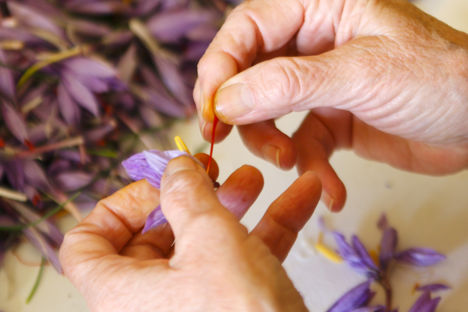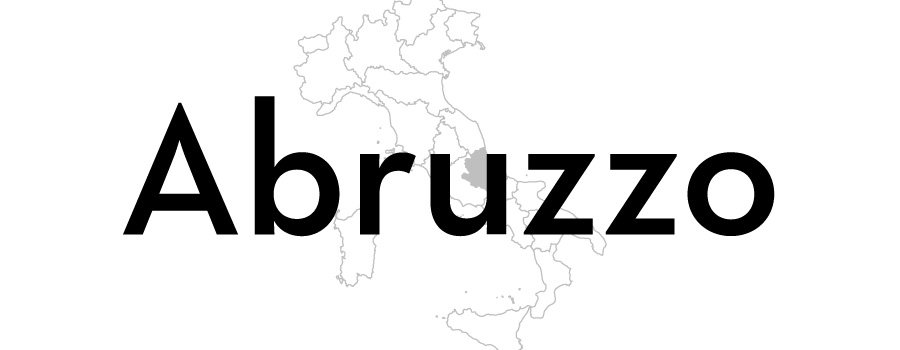
Santucci’s legacy: the saffron plains of Abruzzo
Just eight hectares of land are dedicated to saffron production in Abruzzo, but the harvested stems are widely regarded as the best in the world. And it’s all thanks to one thirteenth century monk.
Santucci’s legacy: the saffron plains of Abruzzo
Just eight hectares of land are dedicated to saffron production in Abruzzo, but the harvested stems are widely regarded as the best in the world. And it’s all thanks to one thirteenth century monk.
If it wasn’t for its intense colour, incredibly fragrant flavour and stunning ability to transform dishes, no one would bother growing and harvesting saffron. It is back-breaking work – the spice is made from the stems of the Crocus Sativus flower, which have to be gently picked by hand, and it takes roughly 500 hours to harvest a kilogram of saffron from 100,000 flowers. It’s this labour-intensive process that makes the spice more expensive than gold, gram for gram – and chefs can’t get enough of it. But how did this luxurious spice, originally from the Middle East, find its way to the central Italian region of Abruzzo?
The answer, of course, is steeped in myth and legend – as any Italian food worth its salt should be. The story goes that a Dominican monk belonging to the Santucci family (who may or may not have actually existed – the family certainly did but no physical written records of him have been found) brought the spice back to Abruzzo after spending time in Iberia. During this time Iberia was under the rule of the Moors, and so the priest had experienced first-hand the heady, fragrant flavours associated with Middle Eastern cooking. Saffron was one of them.
The monk fled Iberia during the Inquisition, returning home to Abruzzo with the seeds of the Crocus Sativus flower. He supposedly favoured its medicinal properties over its use in cooking, but believed he could grow the spice back home due to the similar climate. The monk was correct – the flowers started growing, and saffron production in Italy was born.
Over the years demand for this exotic spice grew and grew, and soon enough there were several different producers in Abruzzo dedicating their land to saffron production. Wealthy Italian families supposedly loved how it gave food a rich golden hue, and it became an essential ingredient in dishes such as risotto alla Milanese. Cakes and liqueurs relied on it for flavour and colour, as did painters who used it to create dyes. Soon enough demand saw the delicate little stems exported all over Italy, and the little town of Navelli – where the Santucci monk first planted his seeds – became famous across the country. The large nearby city of L’Aquila (now the region’s capital) also grew rapidly, funded by saffron money.
Today, saffron production in Abruzzo is certainly a specialist area of farming. While there were over 400 hectares of saffron fields in the region around 1900, that has shrunk to just eight. That’s because saffron grown in the Middle East – particularly Iran – is much cheaper to produce. But there are clear differences in taste between saffron grown in Abruzzo and saffron from elsewhere, which is why it was given PDO-protected status.
The Navelli plain, where the vast majority of Abruzzo’s saffron is grown, has a unique soil and climate which can be tasted in the spice. At around 800 metres above sea level, the flowers are grown on the mountain slopes of the plain which experience a greater amount of rain than typical saffron fields. This environment, combined with the selective cultivation of the plants, has given Zafferano dell’Aquila DOP a flavour like no other saffron in the world. Another aspect of Abruzzese saffron that sets it apart is how the stems are roasted once harvested. This is done over smouldering logs, which intensifies the flavour and colour of the spice and gives it a longer shelf life.
Despite being home to the best saffron in the world, Abruzzese cuisine is surprisingly lacking in its sweet, floral taste. That’s because it was traditionally exported to Italy’s most wealthy families and far too expensive to be consumed by the locals. That’s less true today and you’ll be able to both buy and taste the saffron in Abruzzo, but there are very few traditional dishes that contain the coveted spice. One such dish, however, is scapece di Vasto, which sees fresh fish and seafood dusted in flour and fried before being submerged in white wine vinegar, white wine and saffron. If prepared correctly, the fish can be kept for up to a month in its special wooden container.
Saffron – whether from Italy or the Middle East – is a beautiful ingredient. But the spice grown and painstakingly harvested in Navelli or L’Aquila is something else entirely. It’s a product that sheds light on Italy’s history, helped shape a region and continues to attract worldwide attention. Zafferano dell’Aquila might be expensive, but it’s certainly worth it.

